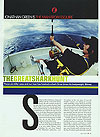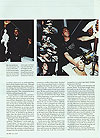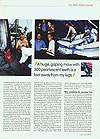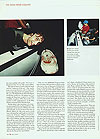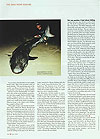» home » portfolio » adventure
Tiger Shark
We sit in abject darkness trying to anticipate, the piercing silence on the swell of the Indian Ocean now at fever pitch. The only sound is the light slap of waves against the boat’s hull. All the lights on the boat, bar the dull glow of the navigation lamps, are off. It’s 10pm and a lighthouse on a cliff to the left casts an eerie revolving finger of light which catches our faces and those of the boat’s crew every minute or so. The waters in the day are normally an enticing azure, tonight they are an inky black, a grim portent of what lurks below.
We are floating on an ebb tide to the west of the island Mauritius in an area called Albion where swimming has just been banned by the Mauritian authorities. Last month, in this very spot, thirty three year old Freddie Lamour, was fishing for octopus while snorkelling. A tiger shark rose from the reef and tore off his left leg and then his head. His mutilated torso was found lying on the reef two days later. This year alone there has been another diver killed by a tiger shark and a female swimmer was also attacked but somehow survived. Tiger sharks are only second in their ferocity and danger to humans than the Great White.
Tonight, aboard Vagabond 2, in an escapade that is looking increasingly foolish, I am here to catch one. Worse, my fishing knowledge is mainly confined to a badly edited video I had ordered from a fishing magazine a week before. Yet roughly six months ago, some and friends and I growing weary of the fugue of London’s pubs and clubs, had decided to charter a boat in a bid to try and catch small Blue shark off the English south coast. Although I caught nothing larger than a rather mournful Whiting the trip held a certain fascination for me. I got in touch with a man recommended by an angling magazine who they promised, knew about catching big game fish.
Graeme Pullen is a small, wiry and obsessive man with a Mako shark’s tooth on a necklace that draws attention in his local town in Fleet, Hampshire. Over the past thirty years, when not running a shop rental business, he has caught big sharks like others catch buses. He suggested this trip and ostensibly we are here to cover the Marlin World Cup, a big game fishing tournament. As I couldn’t enter we decided to go fishing on our own at night when the sharks feed off the reefs. He has come along to make up for my manifest ignorance about fishing.
Tonight as we sit on the fly deck he points at Orion the hunter in the starry, night sky. “A good omen,” he says sotto voce, while also scanning the waters relentlessly. Our bait is somewhat unusual. On cliffs ahead is a battery chicken farm where the carcasses of dead birds are dumped into the sea below and tiger sharks swarm in to swallow them whole. Attached to a five inch, razor sharp hook is a chicken dangling 15 feet below the surface, cut so that blood seeps out. A tiger shark can smell the faintest whiff of blood in enough water that it takes to fill a swimming pool. We have sat for hours barely breaking the silence with desultory flashes of conversation which tail off before even starting. Half asleep with nothing happening, we begin to feel it is time to head back to the hotel.
Then it strikes. The Shimano Tiagra reel, almost the size of a breeze block, suddenly screams as line is dragged out with such speed and ferocity you feel the heavy-duty rod will snap like a twig. All hell breaks lose. The boat’s powerful halogen lights are switched on and the crew shout and jabber in Creole as the boats twin 125hp Mercury outboards fire up. I feel hands dragging me out of my seat, “Mr Jonathan you fight shark now, come.” I feel sick with apprehension as I stumble forward amid the din.
In the stern is the ‘fighting chair.’ I am pushed on to it. The crew put a vest type harness on me, which looks a bit like a life jacket. Clips at the front secure it around my torso and two more are clipped to the heavy duty reel and rod. I am now irrevocably strapped to a very angry tiger shark. Nothing fastens me to the boat.
My legs are shaking with adrenaline and Graeme shouts: “Lock them straight don’t let it pull you out of the boat - it’ll eat ya.” I notice that there’s not a trace of irony flickering around his salt and pepper moustache. I swallow. Hard. Then I plant my feet on the stern of the boat ready to brace for the strain when I am passed the rod. The reel is fitted with a clutch type mechanism that when the shark swims away fighting it lets out line and the fishermen is not dragged out. Yet badly maintained reels can lock and there have been tales of huge men dragged overboard and down to the depths in seconds. Quite how quickly it would take a tiger shark to pull a ten stone pasty-faced Londoner to the bottom doesn’t even bear thinking about.
I am ordered to strike. This is fiercely yanking the rod back five or six times is quick succession to “set the steel” – embed the hook in the sharks mouth. Its enough weight to pick up the rod and reel let alone wave it around like a baton. Frantically I pull the rod back and feel the line go taut on each pull.
With the hook set the long fight begins. The reel is locked up a notch to set the drag so that the amount of line the shark can pull out is reduced – consequently the pressure on me is raised. It’s big everybody says excitedly and only now taking its full strength is it possible to discern quite how powerful. It would jerk my body around like a marionette if it wasn’t for the clever physics of the reel. The harness cuts into my kidneys and waist and my legs continue to shake, my thighs absorbing most of the stress.
As ordered I ease back on the rod and then turn the handle furiously as I ease forward slackening the line. Each action takes enormous effort but only winds in eighteen inches of line. The shark has dragged out 200ft by the time I strike. After four or five turns my confidence increases but the shark thinks otherwise. It fights to be clear and swims the other way dragging out all the line I had painfully reeled in plus another 30 feet. My spirits sink and I wish to god I had worked out in the gym before coming here with cavalier disdain that we would catch nothing bigger than a mackerel.
Drenched in sweat, my face an unbecoming rictus of effort, the shark is being pulled ever closer. All I can hear is the eerie creaking of the line and the harness as everybody on the boat waits wordlessly. Water is poured on the line in the reel as the friction can overheat and break it. Yet the pressure on the harness is so great it snaps a clasp. Crew members hurriedly tie it up. After forty five minutes my legs are completely shot and the looming fear that if they go I will be hauled overboard is increasing. I keep wrestling too with this ridiculous thought that I am fighting to bring a man eating tiger shark inches away from me when most people would prefer quite the opposite. Once, on the verge of giving up, Jacques, a crew member, smiles gently and offers encouragement. I carry on almost punch drunk.
Ten minutes later a powerful light over the water picks out a dorsal fin. And we can make out the ‘leader’ – fifteen feet of steel cable taken from a military tank fastened to the end of the line and attached to the hook – nylon line would be cut in a millisecond by a sharks serrated teeth. The skipper of the boat, Sebastien Pigeot a native Mauritian in his early thirties, is now convinced the shark is bigger than he thought. “We can’t let tiger sharks go they are too dangerous,” he says. He decides to radio into shore to get somebody to bring out a gun to shoot the shark when it gets nearer. Swearing inwardly I wonder how much it hurts to have my limbs ripped off by an angry tiger shark. Even so by now I am reeling in the shark ever closer, just desperate to finish the fight and slump exhausted in the wheelhouse.
Roughly fifty-five minutes since the strike all the line is almost in. The skipper is on the radio calling for a gun but out of the darkness a huge gaping maw with 300 pearlescent white teeth capable of ripping its prey apart with 2000ibs per square inch of pressure is a foot away from my legs on the stern. The gun is not going to arrive in time…
Maybe more frightening is what is happening worldwide. Deerfield beach in Florida is just one of the many resorts around the world now realising a ban on scuba divers swimming with sharks is the only way to save lives. Beaches around Orlando were closed a few weeks ago after shark six attacks in 48 hours. If all this seems reminiscent of the film Jaws - it is because the similarities are frightening.
Statistics from the International Shark Attack file prove this out resoundingly. Last year there were 90 alleged attacks of sharks on humans, with 79 of those confirmed unprovoked attacks on humans. The eleven others included, terrifyingly, four attacks on boats. This was the biggest tally since the ISAF began recording shark attacks in 1958. Two thirds of those were in US waters.
Last year there were 83 unprovoked attacks by Tigers, 23 of those were fatal. Their attacks are ferocious. “If you are bitten by a Tiger you have a good chance of being chewed up,” says John McCosker, a scientist at the California Academy of Sciences.
Yet not only is the Tiger Shark the second most dangerous shark, behind the great white, it eats almost anything. “It is willing to try anything for food,” says Rocky Strong, a shark biologist associated with the Jean-Michael Institute. Not just fish, turtles and sea mammals but also dogs, boots, beer bottles and unopened cans of beans.
So when my tiger shark was inches away my death or maiming was the only thing that concerned me. The shark’s huge jaws and retractable teeth opened and closed wildly as it thrashed beside the boat. The gun option was ruled out. Crew members donning leather gloves, grabbed hold of the steel leader and hauled the shark closer in. Huge poles with fearsome looking hooks on the end known as gaffs were hurriedly taken out of the wheelhouse. Each time someone would try and sink the hook into the shark it would fight to be free. To fall in the water now or to not gaff the shark properly could literally mean someone losing limbs. After ten minutes of shouting and wild lunches at the shark, a billowing stain of blood emerges on the water and the shark is pulled in close with the gaffs to the side of the boat. Jacques reaches for a baseball bat and savagely beats the shark over the head maybe ten to fifteen times. The noise sounds like a bat hitting a hollow softball.
And with that the shark expired and I slumped in the fighting chair, rivulets of blood running over the deck. We motored back to the hotel. I sat on the fly bridge, the sweat drying on my skin and the sea breeze making me slightly chilly as the adrenaline wore off too. As I slugged on a beer, Des’ree’s song Life drifted out of the boats cabin. At that moment, any moral arguments vanished that I may have had. I have never felt more alive.
Back at the hotel it took four men to haul my shark up on the beach. The skipper said it weighed between 500 and 550lbs and in length it was probably twelve to fourteen feet. As I posed for pictures and felt its rough sandpaper like skin it was all I could do to stop my lower jaw hanging down dumbly, incredulous. Tourists at the hotel bustled out excitedly to gape and then went back to the concierge to cancel their snorkelling and scuba diving courses the next day.
I got lucky. Yet while fishing is largely a matter of luck there will always be men like Graeme Pullen who bring something special, unquantifiable to the whole sport. The whole two weeks we were in Mauritius he ignored the glitz and supposed glamour of the marlin world cup. Graeme was fishing twenty hours a day, right up until our flight left. “You never know what you’re gonna get,” he said with a wild leer, eyes ablaze as he went off every night after sharpening his hooks.
